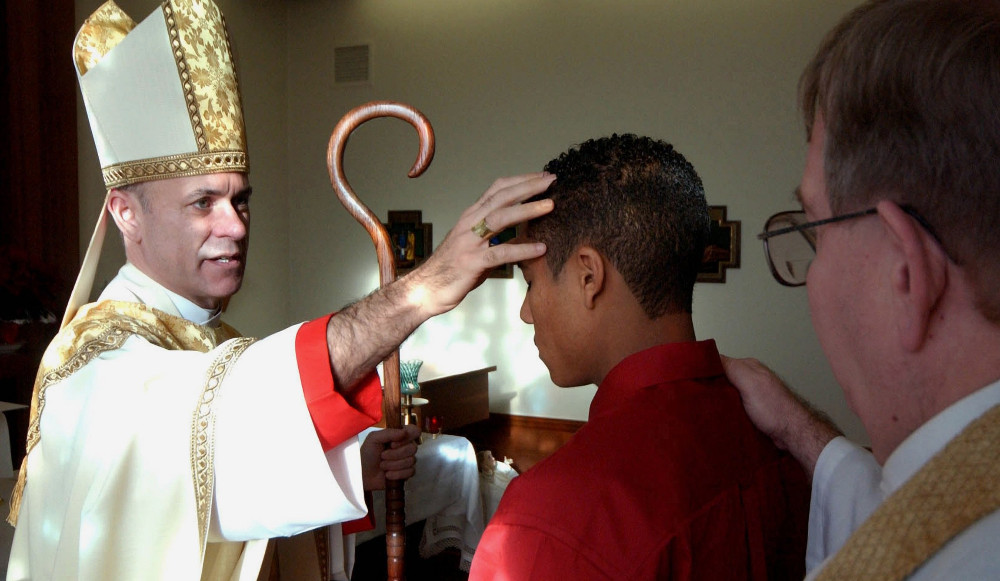The sacraments of baptism and confirmation belong together. It can be confusing, of course, because people experience confirmation in different ways. If you’re baptized as an adult, for instance, you will be confirmed immediately after baptism. However, if you’re baptized as an infant, then you’ll not be confirmed until many years later.
Here is the reason for this. Christian initiation is understood historically in the early Church as one event, wherein the two sacraments of baptism and confirmation, along with the Eucharist, were celebrated together. This was broken up for a variety of practical reasons, giving us the diverse ways in which we can receive confirmation today. It’s critical to know, though, that these two distinct sacraments belong together — and, alongside the Eucharist, form one initiation experience.
The Catechism of the Catholic Church puts it this way: “Baptism, the Eucharist, and the sacrament of Confirmation together constitute the ‘sacraments of Christian initiation,’ whose unity must be safeguarded” (No. 1285). Their unity arises from the fact that these sacraments work together to form the believer into the person of Christ — or as the New Testament puts it, into “the full stature of Christ” (Eph 4:13).
In baptism, a person is born in Christ — grafted, to put it another way, into Christ himself. Confirmation, on the other hand, names the experience of the Holy Spirit shedding his grace upon a Christian even more perfectly, catalyzing the grace already present in the baptized person. The words used by the Catechism are “completion,” “more perfectly bound,” “enriched.” After confirmation, the baptized person is “more strictly obliged to spread and defend the faith by word and deed” (Catechism, No. 1285). One can begin to see from this, of course, how confirmation came to be viewed as a sacrament of adolescence, a sacrament marking one’s growth and development. Confirmation came to be seen as an opportunity for a young person to take ownership of his or her baptism, to be “more strictly obliged” to live the Christian life. This, though, is a later development — a broadening of the meaning of confirmation and not the way Catholics always thought about the sacrament.
This twofold pattern is recognizable in the Bible. We see it in the story of Jesus’ baptism and temptation. After Jesus was baptized by John, after the voice broke from heaven saying, “You are my beloved Son,” we learn in Mark that “the Spirit drove him into the desert,” where he was tested by Satan (Mk 1:9-13). Some of the early Church Fathers saw this passage as a symbol of confirmation. They saw that, like Christ, when we are baptized, we too are called sons or daughters of the Father. And, again like Christ, after baptism, the Spirit drives us out into the wilderness to fight the devil.
In Acts of the Apostles, Peter and John are sent to Samaria, because although believers there “had accepted the word of God,” the Holy Spirit “had not yet fallen upon any of them.” Before the two apostles arrived, believers in Samaria “had only been baptized in the name of the Lord Jesus.” Later, Peter and John laid hands on them, giving them the Holy Spirit (Acts 8:14-17). Although in the New Testament, we do not find a systematic sacramental theology — that would take centuries of synthesis and tradition — we do find the basic elements and ingredients, as it were, of sacramental theology, including the elements of our Catholic belief about baptism and confirmation. We see that their relationship is a relation of presence to perfection and action. In baptism, we’re made present to Christ. In confirmation, we’re perfected and pushed into action by the Spirit.
Father Joshua J. Whitfield is pastor of St. Rita Catholic Community in Dallas and author of “The Crisis of Bad Preaching” (Ave Maria Press, $17.95) and other books. Read more from the series here.

